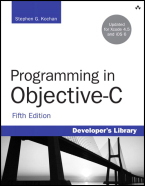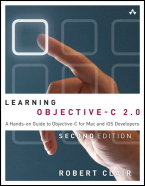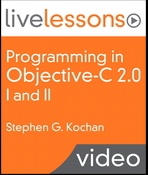Beginning iOS Development
Objective C
Objective-C is the programming language of iOS. A number of features define it as a language. The following are considered key:
- Objects
- Classes as objects
- Messaging
- Categories
- Extensions
- Properties
- Protocols
- Blocks
A basic understanding of these features is essential.
This discussion highlights two excellent books on learning Objective-C: Stephen Kochan’s Programming in Objective-C, Fifth Edition; and Learning Objective-C 2.0: A Hands-On Guide to Objective-C for Mac and iOS Developers, Second Edition, by Robert Clair. Updates to both reflect the latest features in iOS 6.
The readings start with Kochan, who shows how to use either your favorite editor and the Objective-C compiler or the Xcode IDE for basic Objective-C programming.

[00:40]
Objective-C is modeled after Smalltalk but rests on a solid C foundation. Clair provides an excellent summary of C, which is followed by an introduction to the powerful C preprocessor by Kochan.

- Learning Objective-C 2.0: A Hands-On Guide to Objective-C for Mac and iOS Developers, Second Edition, by Robert Clair, Addison-Wesley Professional
[02:00]

[00:30]
The next set of readings are either-or. Either you may read Kochan or you might prefer Clair. Both provide excellent coverage of the key elements. You have had an opportunity to sample both authors. If you have a preference, read that author. As a last resort, flip a coin; or better yet, just read both.
An active and vocal community of developers, designers, and architects generate a demand for a constantly evolving set of conventions within iOS. Apple works hard to incorporate those evolving conventions into each iteration of the language, tools, and frameworks. In their latest round of improvements for iOS 6, they have added a number of features designed to make programming easier and make code more understandable. For instance, objects literals both reduce the amount of code you need to write and make code clearer by removing a lot of clutter.
Besides the improvements made to ease the burden on programmers, keep an eye out for additional features that are either new to iOS 6 or are being emphasized by Apple in this iteration. Changes to properties, ivars, synthesis, and refinements to hiding state are some of the key improvements. With object literals, already mentioned, and object subscripting, you can express object creation and access with cleaner and more-concise syntax. Enums can now have underlying types, and Automatic Reference Counting (ARC) works better with the Core Foundation. You will also find a renewed emphasis on protocols and blocks.

- Programming in Objective-C, Fifth Edition, by Stephen Kochan, Addison-Wesley Professional
- Chapter 3, “Classes, Objects, and Methods”
- Chapter 4, “Data Types and Expressions”
- Chapter 5, “Program Looping”
- Chapter 6, “Making Decisions”
- Chapter 7, “More on Classes”
- Chapter 8, “Inheritance”
- Chapter 9, “Polymorphism, Dynamic Typing, and Dynamic Binding”
- Chapter 10, “More on Variables and Data Types”
- Chapter 11, “Categories and Protocols”
- Chapter 16, “Working with Files”
- Chapter 18, “Copying Objects”
- Chapter 19, “Archiving”
[07:00 – 08:00]

- Learning Objective-C 2.0: A Hands-On Guide to Objective-C for Mac and iOS Developers, Second Edition
- Chapter 3, “An Introduction to Object-Oriented Programming”
- Chapter 4, “Your First Objective-C Program”
- Chapter 5, “Messaging”
- Chapter 6, “Classes and Objects”
- Chapter 7, “The Class Object”
- Chapter 10. Control Structures in Objective-C
- Chapter 11, “Categories, Extensions, and Security”
- Chapter 12, “Properties”
- Chapter 13, “Protocols”
- Chapter 17, “Blocks”
- Chapter 18, “A Few More Things”
[06:00 – 07:00]
Several of the more unique features of the Objective-C language covered in Kochan’s book are also presented by the same author in the following supplemental videos. Be aware, however, that although the videos are somewhat out-of-date in terms of Xcode, they are current with Objective-C 2.0, and still have relevancy in this regard.

- Video: Programming in Objective-C 2.0 LiveLessons, Part I, “Language Fundamentals,” and Part II, “iPhone Programming and the Foundation Framework,” byStephen G. Kochan, Addison-Wesley Professional
- Video: What Is a Class, Object, or Method?
- Video: Properties, Synthesized Accessor Methods, and the dot Operator
- Video: Categories
- Video: Protocols
[01:00]